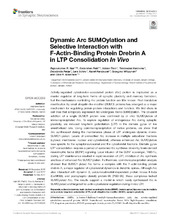| dc.contributor.author | Nair Raveendran, Rajeevkumar | en_US |
| dc.contributor.author | Patil, Sudarshan | en_US |
| dc.contributor.author | Tiron, Adrian | en_US |
| dc.contributor.author | Kanhema, Tambudzai | en_US |
| dc.contributor.author | Panja, Debabrata | en_US |
| dc.contributor.author | Schiro, Lars Erik | en_US |
| dc.contributor.author | Parobczak, Kamil | en_US |
| dc.contributor.author | Wilczynski, Grzegorz M | en_US |
| dc.contributor.author | Bramham, Clive R. | en_US |
| dc.date.accessioned | 2018-02-09T09:01:48Z | |
| dc.date.available | 2018-02-09T09:01:48Z | |
| dc.date.issued | 2017-05-10 | |
| dc.Published | Nair Raveendran R, Patil S, Tiron A, Kanhema T, Panja D, Schiro LE, Parobczak K, Wilczynski GM, Bramham CRE. Dynamic Arc SUMOylation and Selective Interaction with F-Actin-Binding Protein Drebrin A in LTP Consolidation In Vivo. Frontiers in Synaptic Neuroscience. 2017;9:8 | eng |
| dc.identifier.issn | 1663-3563 | |
| dc.identifier.uri | https://hdl.handle.net/1956/17361 | |
| dc.description.abstract | Activity-regulatedcytoskeleton-associated protein (Arc) protein is implicated as a master regulator of long-term forms of synaptic plasticity and memory formation, but the mechanisms controlling Arc protein function are little known. Post-translation modification by small ubiquitin-like modifier (SUMO) proteins has emerged as a major mechanism for regulating protein-protein interactions and function. We first show in cell lines that ectopically expressed Arc undergoes mono-SUMOylation. The covalent addition of a single SUMO1 protein was confirmed by in vitro SUMOylation of immunoprecipitated Arc. To explore regulation of endogenous Arc during synaptic plasticity, we induced long-term potentiation (LTP) in the dentate gyrus of live anesthetized rats. Using coimmunoprecipitation of native proteins, we show that Arc synthesized during the maintenance phase of LTP undergoes dynamic mono-SUMO1-ylation. Levels of unmodified Arc increase in multiple subcellular fractions (cytosol, membrane, nuclear and cytoskeletal), whereas enhanced Arc SUMOylation was specific to the synaptoneurosomal and the cytoskeletal fractions. Dentate gyrus LTP consolidation requires a period of sustained Arc synthesis driven by brain-derived neurotrophic factor (BDNF) signaling. Local infusion of the BDNF scavenger, TrkB-Fc, during LTP maintenance resulted in rapid reversion of LTP, inhibition of Arc synthesis and loss of enhanced Arc SUMO1ylation. Furthermore, coimmunoprecipitation analysis showed that SUMO1-ylated Arc forms a complex with the F-actin-binding protein drebrin A, a major regulator of cytoskeletal dynamics in dendritic spines. Although Arc also interacted with dynamin 2, calcium/calmodulindependentprotein kinase II-beta (CaMKIIβ), and postsynaptic density protein-95 (PSD-95), these complexes lacked SUMOylated Arc. The results support a model in which newly synthesized Arc is SUMOylated and targeted for actin cytoskeletal regulation during in vivo LTP. | en_US |
| dc.language.iso | eng | eng |
| dc.publisher | Frontiers | eng |
| dc.rights | Attribution CC BY | eng |
| dc.rights.uri | http://creativecommons.org/licenses/by/4.0 | eng |
| dc.subject | actin cytoskeleton | eng |
| dc.subject | brain-derived neurotrophic factor (BDNF) | eng |
| dc.subject | dentate gyrus | eng |
| dc.subject | hippocampus | eng |
| dc.subject | immediate early protein | eng |
| dc.subject | long-term potentiation (LTP) | eng |
| dc.subject | small ubiquitin-like modifier (SUMO) | eng |
| dc.subject | synaptic plasticity | eng |
| dc.title | Dynamic Arc SUMOylation and Selective Interaction with F-Actin-Binding Protein Drebrin A in LTP Consolidation In Vivo | en_US |
| dc.type | Peer reviewed | |
| dc.type | Journal article | |
| dc.date.updated | 2018-01-03T09:08:59Z | |
| dc.description.version | publishedVersion | en_US |
| dc.rights.holder | Copyright 2017 The Author(s) | |
| dc.identifier.doi | https://doi.org/10.3389/fnsyn.2017.00008 | |
| dc.identifier.cristin | 1491659 | |
| dc.source.journal | Frontiers in Synaptic Neuroscience | |

